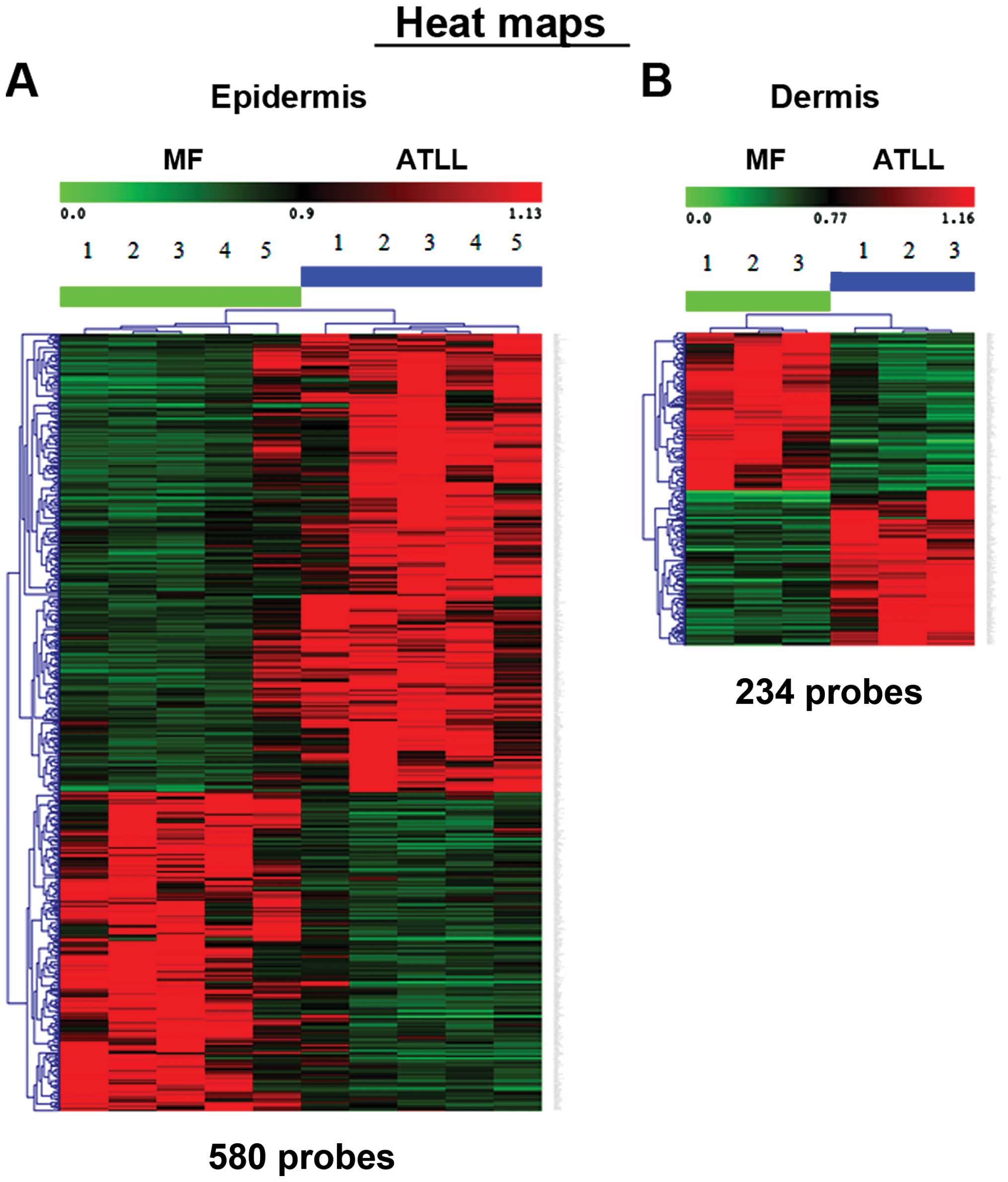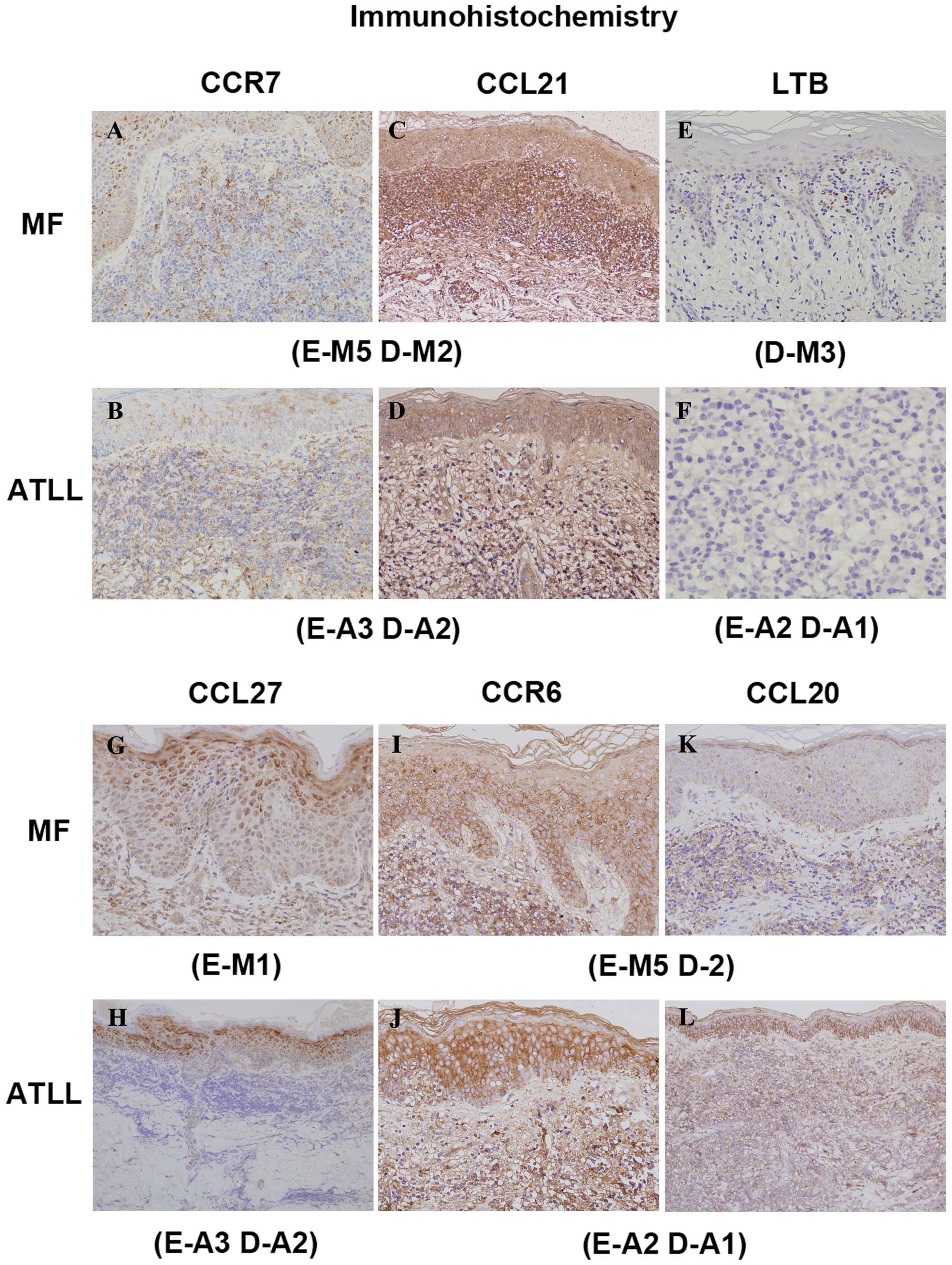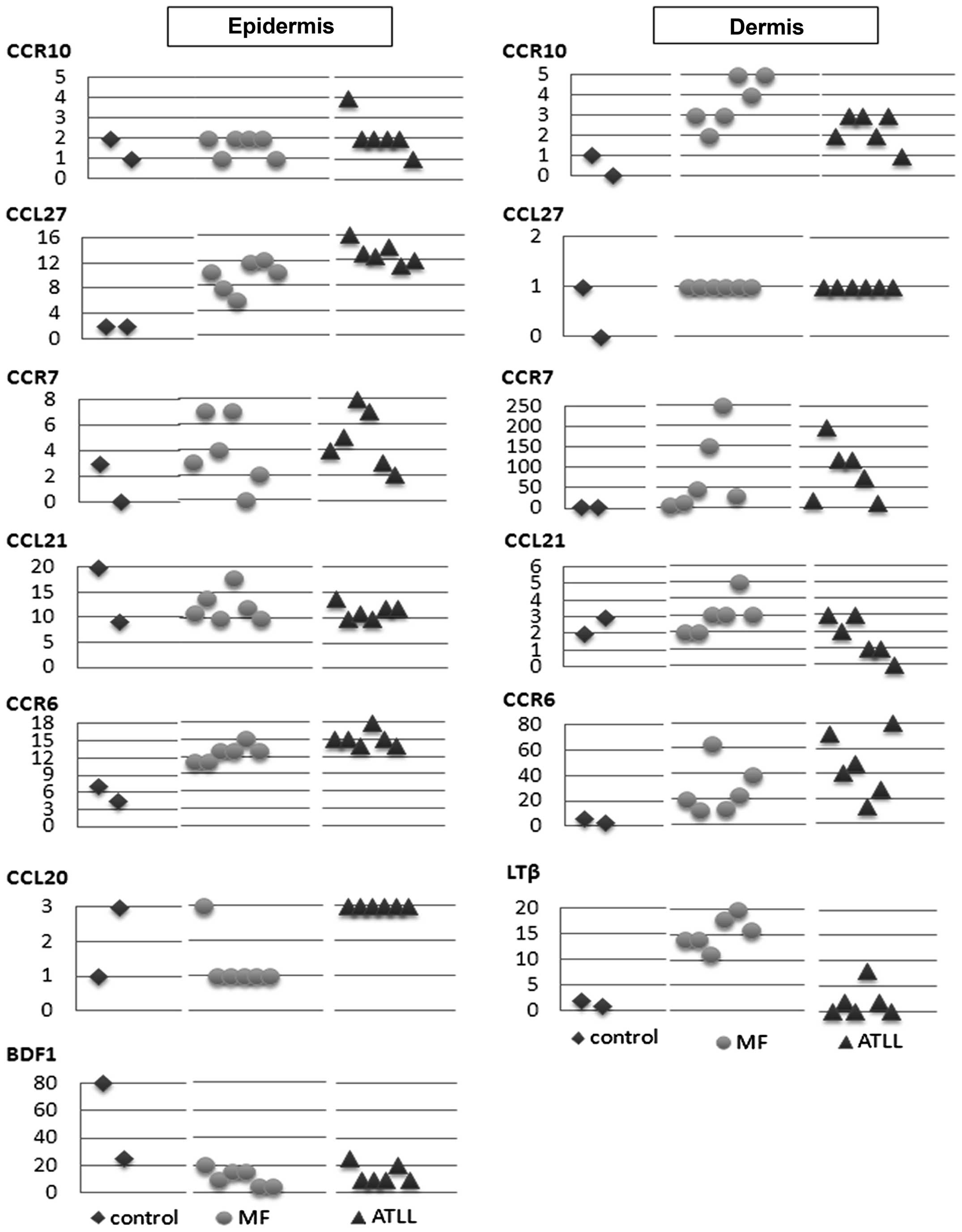|
1
|
Willemze R, Jaffe ES, Burg G, et al:
WHO-EORTC classification for cutaneous lymphomas. Blood.
105:3768–3785. 2009. View Article : Google Scholar
|
|
2
|
Kikuchi A, Ohata Y, Matsumoto H, Sugiura M
and Nishikawa T: Anti-HTLV-1 antibody positive cutaneous T-cell
lymphoma. Cancer. 79:269–274. 1997. View Article : Google Scholar : PubMed/NCBI
|
|
3
|
Notohamiprodjo M, Segerer S, Huss R, et
al: CCR10 is expressed in cutaneous T-cell lymphoma. Int J Cancer.
115:641–647. 2005. View Article : Google Scholar : PubMed/NCBI
|
|
4
|
Picker LJ, Terstappen LW, Rott LS,
Streeter PR, Stein H and Butcher EC: Differential expression of
homing-associated adhesion molecules by T-cell subsets in man. J
Immunol. 145:3247–3255. 1990.PubMed/NCBI
|
|
5
|
Picker LJ, Michie SA, Rott LS and Butcher
EC: A unique phenotype of skin-associated lymphocytes in humans:
preferential expression of the HECA-452 epitope by benign and
malignant T cells at cutaneous sites. Am J Pathol. 136:1053–1068.
1990.PubMed/NCBI
|
|
6
|
Berg EL, Yoshino T, Rott LS, et al: The
cutaneous lymphocyte antigen is a skin lymphocyte homing receptor
for the vascular lectin endothelial cell leukocyte adhesion
molecule 1. J Exp Med. 174:1461–1466. 1991. View Article : Google Scholar : PubMed/NCBI
|
|
7
|
Tanaka Y, Wake A, Horgan KJ, et al:
Distinct phenotype of leukemic T cells with various tissues
tropisms. J Immunol. 158:3822–3829. 1997.PubMed/NCBI
|
|
8
|
Rubin MA: Use of laser capture
microdissection, cDNA microarrays, and tissue microarrays in
advancing our understanding of prostate cancer. J Pathol.
195:80–86. 2001. View
Article : Google Scholar : PubMed/NCBI
|
|
9
|
Lin SM, Du P, Huber W and Kibbe WA:
Model-based variance-stabilizing transformation for Illumina
microarray data. Nucleic Acids Res. 36:e112008. View Article : Google Scholar : PubMed/NCBI
|
|
10
|
Du P, Kibbe WA and Lin SM: lumi: a
pipeline for processing Illumina microarray. Bioinformatics.
24:1547–1548. 2008. View Article : Google Scholar : PubMed/NCBI
|
|
11
|
Tusher VG, Tibshirani R and Chu G:
Significance analysis of microarrays applied to the ionizing
radiation response. Proc Natl Acad Sci USA. 98:5116–5121. 2001.
View Article : Google Scholar : PubMed/NCBI
|
|
12
|
Ohshima K, Kawasaki C, Muta H, et al: CD10
and Bcl10 expression in diffuse large B-cell lymphoma: CD10 is a
marker of improved prognosis. Histopathology. 39:156–162. 2001.
View Article : Google Scholar : PubMed/NCBI
|
|
13
|
Gambichler T, Skrygan M, Appelhans C, et
al: Expression of human beta-defensins in patients with mycosis
fungoides. Arch Dermatol Res. 299:221–224. 2007. View Article : Google Scholar : PubMed/NCBI
|
|
14
|
Browning JL, Dougas I, Ngam-ek A, et al:
Characterization of surface lymphotoxin forms. Use of specific
monoclonal antibodies and soluble receptors. J Immunol. 154:33–46.
1995.PubMed/NCBI
|
|
15
|
Ware CF, Crowe PD, Grayson MH, Androlewicz
MJ and Browning JL: Expression of surface lymphotoxin and tumor
necrosis factor on activated T, B, and natural killer cells. J
Immunol. 149:3881–3888. 1992.PubMed/NCBI
|
|
16
|
Fu YX, Huang G, Wang Y and Chaplin DD: B
lymphocytes induce the formation of follicular dendritic cell
clusters in a lymphotoxin alpha-dependent fashion. J Exp Med.
187:1009–1018. 1998. View Article : Google Scholar : PubMed/NCBI
|
|
17
|
Ware CF: Network communications:
lymphotoxins, LIGHT, and TNF. Annu Rev Immunol. 23:787–819. 2005.
View Article : Google Scholar : PubMed/NCBI
|
|
18
|
Rennert PD, Browning JL, Mebius R, Mackay
F and Hochman PS: Surface lymphotoxin alpha/beta complex is
required for the development of peripheral lymphoid organs. J Exp
Med. 184:1999–2006. 1996. View Article : Google Scholar : PubMed/NCBI
|
|
19
|
Tumanov AV, Kuprash DV and Nedospasov SA:
The role of lymphotoxin in development and maintenance of secondary
lymphoid tissues. Cytokine Growth Factor Rev. 14:275–288. 2003.
View Article : Google Scholar : PubMed/NCBI
|
|
20
|
Dejardin E, Droin NM, Delhase M, et al:
The lymphotoxin-beta receptor induces different patterns of gene
expression via two NF-kappaB pathways. Immunity. 17:525–535. 2002.
View Article : Google Scholar : PubMed/NCBI
|
|
21
|
Dejardin E: The alternative NF-kappaB
pathway from biochemistry to biology: pitfalls and promises for
future drug development. Biochem Pharmacol. 72:1161–1179. 2006.
View Article : Google Scholar : PubMed/NCBI
|
|
22
|
Matsushima A, Kaisho T, Rennert PD, et al:
Essential role of nuclear factor (NF)-kappaB-inducing kinase and
inhibitor of kappaB (IkappaB) kinase alpha in NF-kappaB activation
through lymphotoxin beta receptor, but not through tumor necrosis
factor receptor I. J Exp Med. 193:631–636. 2001. View Article : Google Scholar
|
|
23
|
Hehlgans T, Stoelcker B, Stopfer P, et al:
Lymphotoxin-beta receptor immune interaction promotes tumor growth
by inducing angiogenesis. Cancer Res. 62:4034–4040. 2002.PubMed/NCBI
|
|
24
|
Barkett M and Gilmore TD: Control of
apoptosis by Rel/NF-kappaB transcription factors. Oncogene.
18:6910–6924. 1999. View Article : Google Scholar : PubMed/NCBI
|
|
25
|
Biswas DK, Martin KJ, McAlister C, et al:
Apoptosis caused by chemotherapeutic inhibition of nuclear
factor-kappaB activation. Cancer Res. 63:290–295. 2003.PubMed/NCBI
|
|
26
|
Dhawan P, Su Y, Thu YM, et al: The
lymphotoxin-beta receptor is an upstream activator of
NF-kappaB-mediated transcription in melanoma cells. J Biol Chem.
283:15399–15408. 2008. View Article : Google Scholar : PubMed/NCBI
|
|
27
|
Haybaeck J, Zeller N, Wolf MJ, et al: A
lymphotoxin-driven pathway to hepatocellular carcinoma. Cancer
Cell. 16:295–308. 2009. View Article : Google Scholar : PubMed/NCBI
|
|
28
|
Gilmore TD: Multiple mutations contribute
to the oncogenicity of the retroviral oncoprotein v-Rel. Oncogene.
18:6925–6937. 1999. View Article : Google Scholar : PubMed/NCBI
|
|
29
|
Häcker H and Karin M: Is NF-kappaB2/p100 a
direct activator of programmed cell death? Cancer Cell. 2:431–433.
2002.PubMed/NCBI
|
|
30
|
Martinez-Delgado B, Meléndez B, Cuadros M,
et al: Expression profiling of T-cell lymphomas differentiates
peripheral and lymphoblastic lymphomas and defines survival related
genes. Clin Cancer Res. 10:4971–4982. 2004. View Article : Google Scholar
|
|
31
|
Martinez-Delgado B, Cuadros M, Honrado E,
et al: Differential expression of NF-kappaB pathway genes among
peripheral T-cell lymphomas. Leukemia. 19:2254–2263. 2005.
View Article : Google Scholar : PubMed/NCBI
|
|
32
|
Ballester B, Ramuz O, Gisselbrecht C, et
al: Gene expression profiling identifies molecular subgroups among
nodal peripheral T-cell lymphomas. Oncogene. 25:1560–1570. 2006.
View Article : Google Scholar : PubMed/NCBI
|
|
33
|
Bekiaris V, Gaspal F, Kim MY, et al: CD30
is required for CCL21 expression and CD4 T cell recruitment in the
absence of lymphotoxin signals. J Immunol. 182:4771–4775. 2009.
View Article : Google Scholar : PubMed/NCBI
|
|
34
|
Kallinich T, Muche JM, Qin S, Sterry W,
Audring H and Kroczek RA: Chemokine receptor expression on
neoplastic and reactive T cells in the skin at different stages of
mycosis fungoides. J Invest Dermatol. 121:1045–1052. 2003.
View Article : Google Scholar : PubMed/NCBI
|
|
35
|
Sokolowska-Wojdylo M, Wenzel J, Gaffal E,
et al: Circulating clonal CLA(+) and CD4(+) T cells in Se’zary
syndrome express the skin-homing chemokine receptors CCR4 and CCR10
as well as the lymph node-homing chemokine receptor CCR7. Br J
Dermatol. 152:258–264. 2005.PubMed/NCBI
|
|
36
|
Willemze R, Kerl H, Sterry W, et al: EORTC
classification for primary cutaneous lymphomas: a proposal from the
Cutaneous Lymphoma Study Group of the European Organization for
Research and Treatment of Cancer. Blood. 90:354–371. 1997.
|
|
37
|
Müller A, Homey B, Soto H, et al:
Involvement of chemokine receptors in breast cancer metastasis.
Nature. 410:50–56. 2001.PubMed/NCBI
|
|
38
|
von Andrian UH and Mempel TR: Homing and
cellular traffic in lymph nodes. Nat Rev Immunol. 3:867–878.
2003.PubMed/NCBI
|
|
39
|
Balkwill F: Cancer and the chemokine
network. Nat Rev Cancer. 4:540–550. 2004. View Article : Google Scholar
|
|
40
|
Jones D, O’Hara C, Kraus MD, et al:
Expression pattern of T-cell-associated chemokine receptors and
their chemokines correlates with specific subtypes of T-cell
non-Hodgkin lymphoma. Blood. 96:685–690. 2000.PubMed/NCBI
|
|
41
|
Ferenczi K, Fuhlbrigge RC, Pinkus J,
Pinkus GS and Kupper TS: Increased CCR4 expression in cutaneous T
cell lymphoma. J Invest Dermatol. 119:1405–1410. 2002. View Article : Google Scholar : PubMed/NCBI
|
|
42
|
Narducci MG, Scala E, Bresin A, et al:
Skin homing of Se’zary cells involves SDF-1-CXCR4 signaling and
down-regulation of CD26/dipeptidylpeptidase IV. Blood.
107:1108–1115. 2006.
|
|
43
|
Tang HL and Cyster JG: Chemokine
up-regulation and activated T cell attraction by maturing dendritic
cells. Science. 284:819–822. 1999. View Article : Google Scholar : PubMed/NCBI
|
|
44
|
Wu M, Fang H and Hwang ST: Cutting edge:
CCR4 mediates antigen-primed T cell binding to activated dendritic
cells. J Immunol. 167:4791–4795. 2001. View Article : Google Scholar : PubMed/NCBI
|
|
45
|
Edelson RL: Cutaneous T cell lymphoma: the
helping hand of dendritic cells. Ann N Y Acad Sci. 941:1–11. 2001.
View Article : Google Scholar : PubMed/NCBI
|
|
46
|
Homey B, Alenius H, Müller A, et al:
CCL27-CCR10 interactions regulate T cell-mediated skin
inflammation. Nat Med. 8:157–165. 2002. View Article : Google Scholar : PubMed/NCBI
|
|
47
|
Fujita Y, Abe R, Sasaki M, et al: Presence
of circulating CCR10+ T cells and elevated serum
CTACK/CCL27 in the early stage of mycosis fungoides. Clin Cancer
Res. 12:2670–2675. 2006.PubMed/NCBI
|
|
48
|
Kagami S, Sugaya M, Minatani Y, et al:
Elevated serum CTACK/CCL27 levels in CTCL. J Invest Dermatol.
126:1189–1191. 2006. View Article : Google Scholar : PubMed/NCBI
|
|
49
|
Berger CL, Tigelaar R, Cohen J, et al:
Cutaneous T-cell lymphoma: malignant proliferation of T-regulatory
cells. Blood. 105:1640–1647. 2005. View Article : Google Scholar : PubMed/NCBI
|
|
50
|
Karube K, Aoki R, Sugita Y, et al: The
relationship of FOXP3 expression and clinicopathological
characteristics in adult T-cell leukemia/lymphoma. Mod Pathol.
21:617–625. 2008. View Article : Google Scholar : PubMed/NCBI
|












